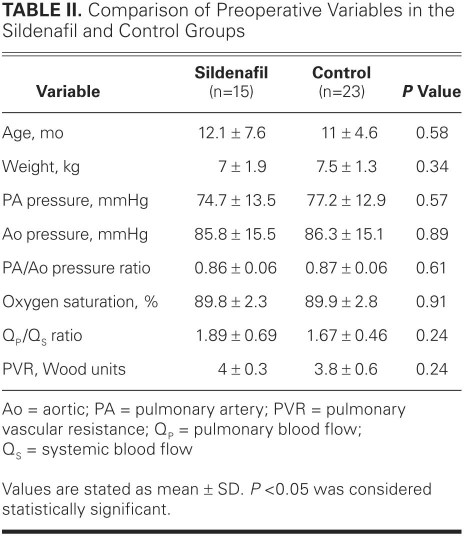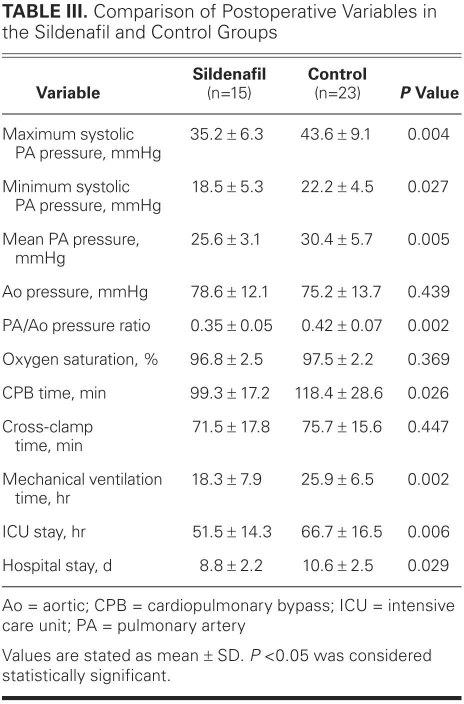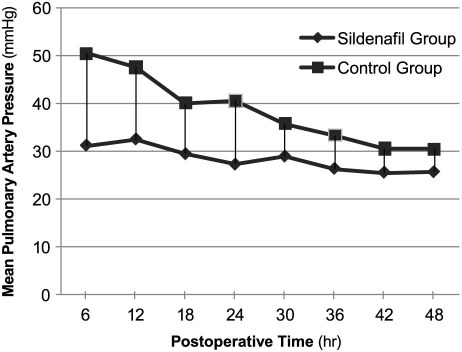Abstract
Pulmonary hypertension associated with pediatric congenital heart defects is a major cause of postoperative morbidity and death. Sildenafil has been combined with inhaled nitric oxide to treat pulmonary hypertension. We retrospectively studied the pre- and postoperative effects of oral sildenafil as monotherapy in children with pulmonary hypertension who underwent surgery to correct congenital cardiac defects.
From September 2005 through November 2009, 38 children with moderate-to-severe pulmonary arterial hypertension (pulmonary arterial/aortic pressure ratio, >0.7) underwent cardiac surgery at our institution. Fifteen patients were given sildenafil (0.35 mg/kg, every 4 hr) orally or through nasogastric tubes 1 week before and 1 week after surgery. Twenty-three patients of comparable medical status were given sildenafil only upon the institution of cardiopulmonary bypass and for 1 week after surgery.
Postoperatively, the 15 patients who were given preoperative sildenafil had significantly lower mean pulmonary arterial pressures (25.6 ± 3.1 vs 30.4 ± 5.7 mmHg; P = 0.005) and pulmonary arterial/aortic pressure ratios (0.35 ± 0.05 vs 0.42 ± 0.07; P = 0.002) than did the other 23 patients. The preoperative therapy also shortened cardiopulmonary bypass time, mechanical ventilation time, and lengths of intensive care unit and hospital stays. No sildenafil-related hypertensive crises or sequelae occurred.
As monotherapy, oral sildenafil in low doses appears to control pulmonary hypertension safely and effectively in children undergoing operations to correct congenital heart defects, particularly when it is given both preoperatively and postoperatively. Further study is warranted.
Key words: 3′,5′-cyclic-GMP phosphodiesterases/antagonists & inhibitors; antihypertensive agents/therapeutic use; heart defects, congenital/surgery; hemodynamics/drug effects; hypertension, pulmonary/drug therapy/prevention & control; piperazines/therapeutic use; postoperative complications/prevention & control; sildenafil; treatment outcome; vasodilator agents/therapeutic use
Pulmonary hypertension (PH) associated with congenital heart defects in children is a major cause of postoperative morbidity and death.1 Inhaled nitric oxide (NO), a selective pulmonary vasodilator, has been the therapy of choice for controlling PH after cardiac surgery. The activation of soluble guanylate cyclase converts guanine triphosphate to cyclic guanosine monophosphate (cGMP), which in turn leads to the activation of protein kinases and to subsequent vascular relaxation.2 Life-threatening sequelae can occur when inhaled NO is abruptly discontinued.
Sildenafil citrate has been used to treat PH in adults and children.3–8 Sildenafil is a selective phosphodiesterase-5 inhibitor.9 Phosphodiesterase 5 specifically hydrolyzes 3′, 5′-GMP. Sildenafil produces acute and relatively selective pulmonary vasodilation and acts synergistically with inhaled NO.10–13 Available evidence suggests that sildenafil has useful effects in PH, particularly in chronic therapy and in attenuating rebound effects after inhaled NO is discontinued.2,8 Sildenafil is well tolerated and available as an oral preparation, which is advantageous for patients with PH whose symptoms do not warrant a continuous intravenous infusion. Nonetheless, dosage levels vary widely, and few data are available to suggest dosage regimens for children.
This retrospective study was performed to investigate the effect of oral sildenafil as monotherapy in controlling pre- and postoperative PH in children undergoing congenital cardiac surgery.
Patients and Methods
From September 2005 through November 2009, 38 pediatric patients with moderate-to-severe PH (pulmonary arterial/aortic [PA/Ao] pressure ratio, >0.7; and pulmonary vascular resistance, >3 Wood units) underwent corrective surgery at our institution for congenital cardiac defects and were enrolled in this study. Written informed consents were obtained, and our local ethics committee approved the protocol. One month before surgery, each of the 38 patients underwent cardiac catheterization. During this process, PA and aortic pressure, pulmonary vascular resistance, and oxygen saturation were measured directly, and PA/Ao pressure ratios and pulmonary-to-systemic blood flow ratios were calculated.
The sildenafil group included 15 consecutive patients who were given sildenafil before and after surgery (Table I). The control group comprised 23 consecutive patients who were given sildenafil only at the start of cardiopulmonary bypass (CPB) and after surgery.
TABLE I. Patients' Characteristics and Preoperative Cardiac Catheterization Data in the Sildenafil Group
The mean age in the sildenafil group was 12.1 ± 7.6 mo (range, 6–33 mo), compared with 11 ± 4.6 mo (range, 5–25 mo) in the control group (P = 0.58) (Table II). Nine patients in the sildenafil group and 10 in the control group were male. The mean body weight in the sildenafil group was 7 ± 1.9 kg (range, 4.4–11.5 kg), compared with 7.5 ± 1.3 kg (range, 5.7–10.8 kg) in the control group (P = 0.34). In the sildenafil group, 12 patients had a ventricular septal defect; associated anomalies included 4 cases of patent ductus arteriosus, 2 of atrial septal defect, and 1 aortopulmonary window. The 3 remaining patients had an atrioventricular septal defect. In the control group, 19 patients had a ventricular septal defect; associated anomalies were 8 cases of patent ductus arteriosus and 4 of atrial septal defect. The 4 remaining patients had an atrioventricular septal defect. There were no statistically significant differences between the 2 groups in regard to preoperative characteristics (Table II). No patient had genetic syndrome in either group.
TABLE II. Comparison of Preoperative Variables in the Sildenafil and Control Groups
The patients in the sildenafil group were given 0.35 mg/kg of the medication orally or through a nasogastric tube every 4 hours. The therapy began 1 week before surgery and continued for 1 week thereafter. The patients in the control group received this dose before the start of CBP and for 1 week postoperatively.
Postoperatively, patients were transferred to the intensive care unit (ICU). In addition to sildenafil, therapy included 1 to 15 μg/kg/min of dopamine (0.05–1 μg/kg/min of adrenaline was added, when necessary), 0.1 mg/kg/hr of cistracurium for muscle relaxation, and 0.075 to 0.15 μg/kg/min of remifentanil and 0.5 to 2 μg/kg/min of midazolam for sedation. Controlled hyperventilation was instituted in order to attain blood pH values above 7.45 and PaO2 levels above 100 mmHg. No other vasodilator was administered. Systemic and pulmonary pressures were measured every hour for 2 days through systemic arterial and PA lines. The recorded PA pressures, PA/Ao ratios, oxygen saturation levels, CPB and aortic cross-clamp times, mechanical ventilation time, and ICU and hospital stays were compared between the 2 groups.
Statistical Analysis
Continuous data were expressed as mean ± SD. The nonparametric Mann-Whitney U test was used to compare continuous clinical variables between the groups. Data were analyzed by use of STATISTICA 6.0 software (StatSoft, Inc.; Tulsa, Okla). A P value <0.05 was considered statistically significant.
Results
No postoperative deaths occurred in either group. The maximum, minimum, and mean systolic PA pressures were significantly lower in the sildenafil group than in the control group (P = 0.004, P = 0.027, and P = 0.005, respectively). The PA/Ao pressure ratio decreased in all patients; however, it was significantly lower in the sildenafil group than in the control group (0.35 ± 0.05 vs 0.42 ± 0.07; P = 0.002). There were also significant differences in CPB time, mechanical ventilation time, and ICU and hospital stays, all of which were lower in the sildenafil group (Table III). There were no significant differences in cross-clamp time, aortic pressure, and oxygen saturation level.
TABLE III. Comparison of Postoperative Variables in the Sildenafil and Control Groups
No hypertensive crisis or significant systemic hypotension was detected in either group. No sildenafil-related sequelae occurred in pre- or postoperative use. The frequency of sildenafil dosages was gradually reduced after the 3rd postoperative day, and therapy ended a week after the operation.
Echocardiographic results upon the patients' hospital discharge showed discrete biventricular contractility, maximal PA pressures of 40 mmHg, and no hemodynamically significant residual shunts. In no instance was it necessary to resume therapy for PH.
Discussion
Currently, inhaled NO is the therapy of choice for residual PH after the repair of congenital cardiac defects. However, 2 limitations of inhaled NO are the incomplete elimination of pulmonary hypertensive crisis, and fatal rebound PH after NO is discontinued.2,6,13 In addition, a special device is required to administer the agent. To overcome these shortcomings, sildenafil can be added to inhaled NO or used alone.2,13,14 It has been postulated that rebound PH is caused when exogenous NO inhibits NO synthase activity through negative feedback when inhaled NO is abruptly discontinued.2 The inhibition of phosphodiesterase 5 by sildenafil—by increasing intracellular and circulating cGMP—prevents the rapid depletion of cGMP when inhaled NO is withdrawn, thus potentiating the pulmonary vasodilatory effect of the agent.2,6,13
Reports of oral sildenafil use for pre- and postoperative PH have chiefly involved cases in which it was difficult to wean patients from inhaled NO, or in which NO was not optimally effective. Sildenafil was added to inhaled NO or other pulmonary vasodilators2,13–15 and was only rarely used as monotherapy.16 These few reports substantiate the effectiveness of sildenafil as a pulmonary vasodilator and its benefit as short-term therapy for patients with PH.
Because experience with oral sildenafil as monotherapy is minimal, an optimal dose has not yet been established. Before and after surgery, our patients were given a low dose of 0.35 mg/kg and no concomitant pulmonary vasodilators. The preoperative use of sildenafil brought our patients to surgery in better condition and led to better postoperative results, without sequelae (Fig. 1).
Fig. 1 Comparison of mean pulmonary artery pressure between the sildenafil and control groups during the first 48 hours after surgery.
The duration of CPB has an important impact on time-related changes in pulmonary vascular reactivity after cardiac surgery. Pulmonary hypertension is a recognized effect of ischemia/reperfusion injury after on-pump surgery.17 Cardiopulmonary bypass can lead to pulmonary endothelial-cell injury and pulmonary dysfunction, probably from hypoperfusion of the lung during CPB; or from activation of the systemic inflammatory response, which exacerbates the reactivity of the pulmonary vascular bed. This may result in inhibited NO production and increased production of endothelin-1 after CPB.18 Some of the changes induced by CPB could reverse themselves after sildenafil administration. In our study, the preoperative use of sildenafil could have reduced CPB time by decreasing the inflammatory response.
Our study has some limitations. It included relatively few patients, and the cases were retrospectively reviewed. It is unclear whether the results of the study were directly associated with sildenafil, because other factors could have influenced postoperative outcomes. Accordingly, a large, multicenter, randomized controlled trial is warranted to validate the efficacy of sildenafil pre- and postoperatively in comparison with placebo or other vasodilators.
In summary, our findings suggest that oral sildenafil effectively minimizes pre- and postoperative PH in pediatric cardiac patients. In particular, sildenafil therapy before cardiac surgery appears to have a positive effect on postoperative management. Larger, randomized studies are necessary to determine the efficacy, safety, and optimal doses of sildenafil in children who undergo surgery for the correction of congenital heart defects.
Footnotes
Address for reprints: Raffaele Giordano, MD, Via G. Filangieri 125/A, Cava de'Tirreni (SA) 84013, Italy
E-mail: raf_jordan@inwind.it
References
- 1.Knoderer CA, Ebenroth ES, Brown JW. Chronic outpatient sildenafil therapy for pulmonary hypertension in a child after cardiac surgery. Pediatr Cardiol 2005;26(6):859–61. [DOI] [PubMed]
- 2.Atz AM, Wessel DL. Sildenafil ameliorates effects of inhaled nitric oxide withdrawal. Anesthesiology 1999;91(1):307–10. [DOI] [PubMed]
- 3.Michelakis ED, Tymchak W, Noga M, Webster L, Wu XC, Lien D, et al. Long-term treatment with oral sildenafil is safe and improves functional capacity and hemodynamics in patients with pulmonary arterial hypertension. Circulation 2003;108(17):2066–9. [DOI] [PubMed]
- 4.Bhatia S, Frantz RP, Severson CJ, Durst LA, McGoon MD. Immediate and long-term hemodynamic and clinical effects of sildenafil in patients with pulmonary arterial hypertension receiving vasodilator therapy. Mayo Clin Proc 2003;78(10): 1207–13. [DOI] [PubMed]
- 5.Stocker C, Penny DJ, Brizard CP, Cochrane AD, Soto R, Shekerdemian LS. Intravenous sildenafil and inhaled nitric oxide: a randomised trial in infants after cardiac surgery. Intensive Care Med 2003;29(11):1996–2003. [DOI] [PubMed]
- 6.Schulze-Neick I, Hartenstein P, Li J, Stiller B, Nagdyman N, Hubler M, et al. Intravenous sildenafil is a potent pulmonary vasodilator in children with congenital heart disease. Circulation 2003;108 Suppl 1:II167–73. [DOI] [PubMed]
- 7.Ghofrani HA, Olschewski H, Seeger W, Grimminger F. Sildenafil for treatment of severe pulmonary hypertension and commencing right-heart failure [in German]. Pneumologie 2002;56(11):665–72. [DOI] [PubMed]
- 8.Kothari SS, Duggal B. Chronic oral sildenafil therapy in severe pulmonary artery hypertension. Indian Heart J 2002;54 (4):404–9. [PubMed]
- 9.Reffelmann T, Kloner RA. Therapeutic potential of phosphodiesterase 5 inhibition for cardiovascular disease. Circulation 2003;108(2):239–44. [DOI] [PubMed]
- 10.Prasad S, Wilkinson J, Gatzoulis MA. Sildenafil in primary pulmonary hypertension. N Engl J Med 2000;343(18):1342. [DOI] [PubMed]
- 11.Abrams D, Schulze-Neick I, Magee AG. Sildenafil as a selective pulmonary vasodilator in childhood primary pulmonary hypertension. Heart 2000;84(2):E4. [DOI] [PMC free article] [PubMed]
- 12.Zhao L, Mason NA, Morrell NW, Kojonazarov B, Sadykov A, Maripov A, et al. Sildenafil inhibits hypoxia-induced pulmonary hypertension. Circulation 2001;104(4):424–8. [DOI] [PubMed]
- 13.Atz AM, Lefler AK, Fairbrother DL, Uber WE, Bradley SM. Sildenafil augments the effect of inhaled nitric oxide for postoperative pulmonary hypertensive crises. J Thorac Cardiovasc Surg 2002;124(3):628–9. [DOI] [PubMed]
- 14.Trachte AL, Lobato EB, Urdaneta F, Hess PJ, Klodell CT, Martin TD, et al. Oral sildenafil reduces pulmonary hypertension after cardiac surgery. Ann Thorac Surg 2005;79 (1):194–7. [DOI] [PubMed]
- 15.Bentlin MR, Saito A, De Luca AK, Bossolan G, Bonatto RC, Martins AS, Rugolo LM. Sildenafil for pulmonary hypertension treatment after cardiac surgery [in Portuguese]. J Pediatr (Rio J) 2005;81(2):175–8. [PubMed]
- 16.Peiravian F, Amirghofran AA, Borzouee M, Ajami GH, Sabri MR, Kolaee S. Oral sildenafil to control pulmonary hypertension after congenital heart surgery. Asian Cardiovasc Thorac Ann 2007;15(2):113–7. [DOI] [PubMed]
- 17.Chai PJ, Williamson JA, Lodge AJ, Daggett CW, Scarborough JE, Meliones JN, et al. Effects of ischemia on pulmonary dysfunction after cardiopulmonary bypass. Ann Thorac Surg 1999;67(3):731–5. [DOI] [PubMed]
- 18.Lindberg L, Olsson AK, Jogi P, Jonmarker C. How common is severe pulmonary hypertension after pediatric cardiac surgery? J Thorac Cardiovasc Surg 2002;123(6):1155–63. [DOI] [PubMed]






